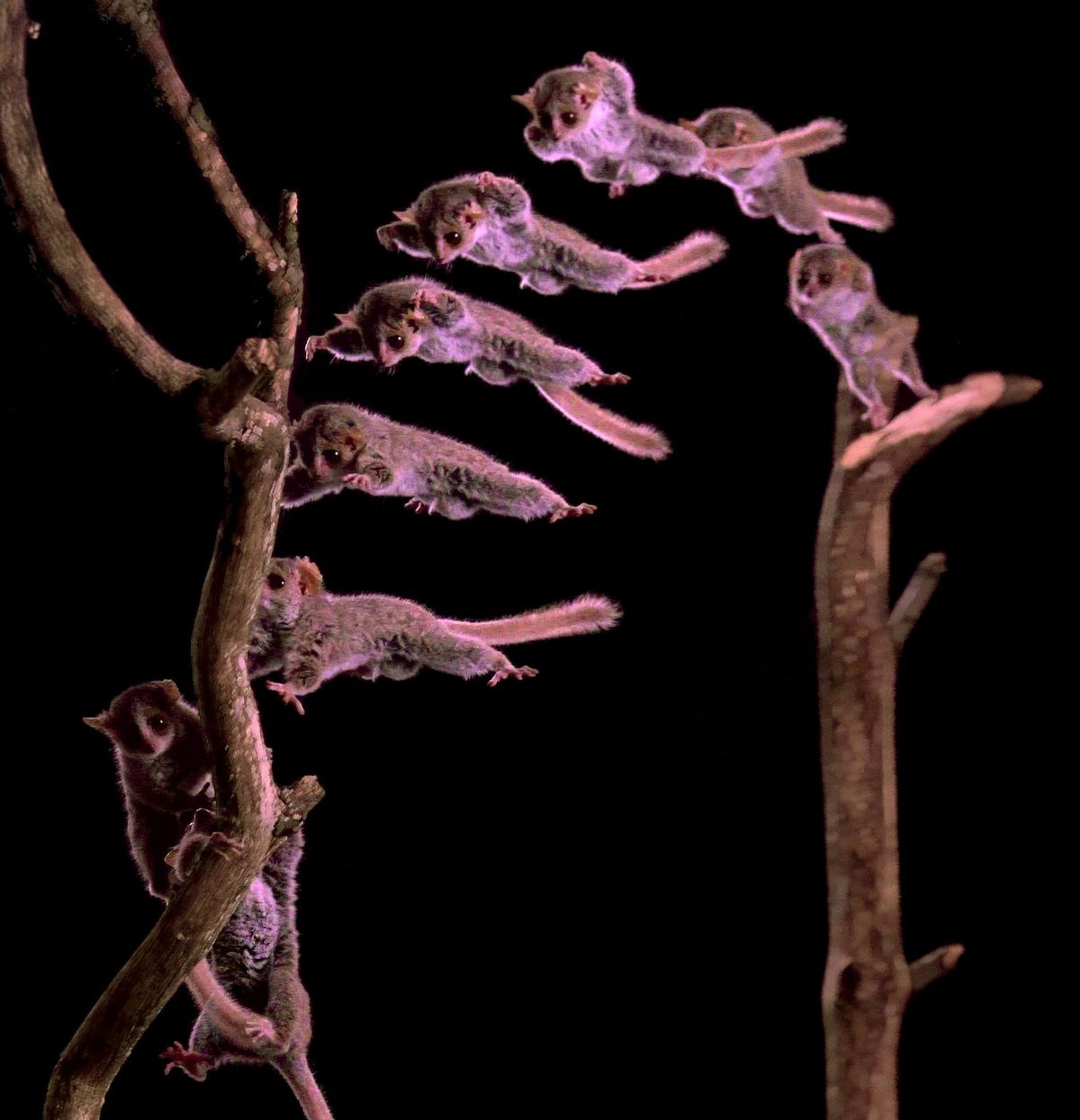New research suggests that the design of the visual processing system of Madagascar’s gray mouse lemur holds secrets about the origins of vision for humans and for primates around the world.

A single mouse lemur leaping from branch to branch.
Courtesy of Daniel Huber, University of Geneva
Leaping about in the jungles, the gray mouse lemur could easily be confused with an actual mouse — but only if mice had monkey-like bushy tails and were given to vaulting and bounding. This lemur’s part-primate/part-rodent appearance may have to do with the fact that its evolutionary roots probably date from about 55 million years ago, when primates and rodents first took divergent evolutionary paths. Today, it still shares many physical traits with fossils of Earth’s earliest primates.
“Gray” is just one of many species of mouse lemurs. Despite being genetically unique and sometimes having distinctive mating calls, the various mouse lemur species look so similar that they are considered “cryptic”; it’s hard to tell them apart. In general, mouse lemurs weigh about two ounces, maybe a little more. They are the smallest known genus of primate.
Recent research comparing the visual processing system of the gray mouse lemur with that of much larger and more recently evolved primates including humans suggests that, once the visual cortex of very early primates settled into a highly functional design, it didn’t evolve much further. Publishing in the February 2021 issue of Current Biology, scientists at the University of Geneva, the Max Planck Institute in Göttingen, and the National Museum of Natural History in Paris propose that, for modern primates of any size, the fundamental units of the visual cortex may be nearly identical in function, design, and size to those of the gray mouse lemur.
In their Current Biology article, the researchers describe using optical imaging methods to peer into the gray mouse lemur’s primary visual cortex. There they witnessed sight in action. As the lemurs were shown visual stimuli consisting of moving gratings oriented in eight different directions, the researchers detected in their visual cortices the emergence of precise patterns of neuronal signaling. They also saw that patterns of neuronal activity were organized in the small patches that, in the late 1950s and early 1960s, researchers at Harvard Medical School and Johns Hopkins University described as “columns.” They saw that, distributed across the gray mouse lemur visual cortex, columns packed with neurons formed functional “orientation maps.” Neighboring maps with different orientation sensitivities were arranged in a circular fashion, forming pinwheel-like shapes.
In a phone interview, Daniel Huber, an associate professor at the department of Basic Neurosciences at the University of Geneva, likened the visual processing system of the gray mouse lemur to that of a camera. “A ‘pinwheel’ containing multiple, neighboring columns integrates discrete bits of visual information,” he explained. “It’s analogous to the electronic circuitry in a digital camera, which processes information from neighboring red, green and blue ‘pixels’ into a single color.”
In their Current Biology article, Huber and his fellow researchers compare their findings about the visual cortices of gray mouse lemurs with data about larger primates. They demonstrate that, across all of the primates species they studied, the architecture is the same. As Huber explained, this suggests that, “how the gray mouse lemur sees and interprets basic visual information may be how all primates everywhere do.”

Gray mouse lemur.
Courtesy Daniel Huber, University of Geneva
Surprisingly, Huber and his colleagues also found that the size of the columns is the same from one primate species to another. “They are virtually identical across three orders of magnitude in body size.”
How can a two-ounce and a 140-pound primate have same-sized columns? According to Huber, “It’s possible that this basic unit in primate vision cannot be simplified or scaled down.”
This would require a silverback gorilla’s columns to be so thriftily packed as to fit into the primary visual cortex of a lemur whose brain is the size of a human fingertip. Indeed, in the Currrent Biology article, the researchers speculate that the organization of neurons into columns and of columns into pinwheels minimizes the length of “wiring” needed within the primary visual cortex, thereby economizing on volume.
While the basic visual unit size is about the same from species to species, according to Huber, “the primary visual cortex of a larger primate simply contains more of those units.”
Huber also noted that “the fact that the units themselves are not simplified or scaled down in smaller species would indicate that they are a product of early primate evolution.” Fossils of those earliest primates are very small.
According to Huber, fifty-five million years of stability is extraordinary in a complex biological system that serves so many different species.
The gray mouse lemur was declared a threatened species in 1975, though now the International Union for Conservation of Nature Red List of Threatened Species numbers it among those of the Least Concern. Still its habitat is dying back precipitously, and it is frequently caught to be sold as pets. Considering how closely today’s gray mouse lemurs resemble the fossils of the very earliest primates, if the entire species disappears one day, so will a treasure chest of information about human vision, and even about humans in general.
This article is auto-generated by Algorithm Source: www.forbes.com


